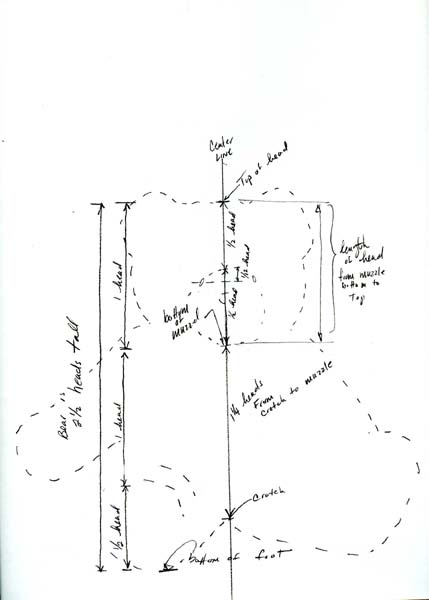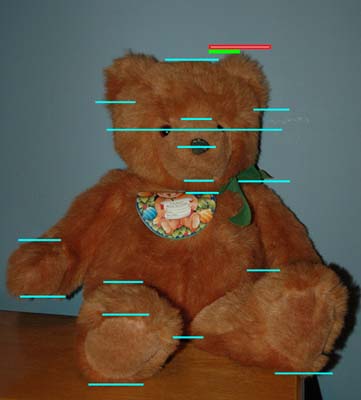
Art Classes with Marc Surrency







Class 1: Measurement
Revisiting Mr. Bear
Step 1
In accurately drawing or painting the bear we have to accurately locate some important landmarks. To accomplish this we simply define the landmarks, and then locate their position. To locate their position we establish a vertical and horizontal axis with an origin and define a unit of measure. We then determine how many units each landmark vertically and horizontally from the origin. Essentially all we're doing is graphing.
Define important landmarks on the bear and then Locate their vertical locations. Here I've placed horizontal blue lines to show the most important landmarks and the ones that I'll be starting with.
I've marked the top of the head, top of the muzzle, lower edges of the ears, the center line of the right eye, the center of the nose, the bottom of the muzzle, the change in direction between the left shoulder and the bow, the actual bottom of the head, the top of the right paw, the location where the edges of the left arm, leg, and body meet, the bottom of the right paw, the top of the right leg joint, the crotch, and the bottom of the feet.
Now its time to locate these points on the paper or canvas.
I start by locating where the center line is going to be. I selected to place the line down the center of the head. This is the most important stroke of the whole painting - It's our vertical axis. All of the measurements will use this as an anchor. I arbitrarily select the top of the bear's head as the origin and location of the horizontal axis.
Remember your "ruler" is the distance between your thumb and the tip of your brush with your arm stretched straight out and viewing with one eye.
Next I decide what unit of length to use as a measuring tool. I decided on the distance from the top of the head to the bottom of the muzzle along the center line. For the sketches, I've labeled this distance as the "head". All distances will be measured using the "head" as a unit.
For example, I hold out my thumb and brush and measure the distance between the top of the head and the bottom of the muzzle. This is my unit and I keep my thumb position on the brush handle constant. To measure the vertical distance from the top of the head to the muzzle I line up the the bottom of my thumb with the bottom of the muzzle and estimate the distance from my thumb to the top of the head against the distance from my thumb to the top of the brush (1 head long). In this case the distance between the top of the muzzle to the top of the head is about half of the distance between my thumb and the top of the handle of the brush.
Therefore, the top of the muzzle is half a head from the top of the head. Since this position is half a head, I can check it by measuring the distance from the top of the head to the top of the muzzle and then checking it against the distance from the top of the muzzle to the bottom of the muzzle. The distance should be the same.
I've continued the process to determine the total height of the bear (2 1/2 heads tall) and the position of the crotch (1 1/4 heads from the bottom of the muzzle to the crotch)'

© 2005, 2004, 2003, 2002 Marc J. Surrency. Artist scans, images, and web design are protected by copyright. Physical or electronic reproduction in whole or part is unlawful without written permission of the artist.

